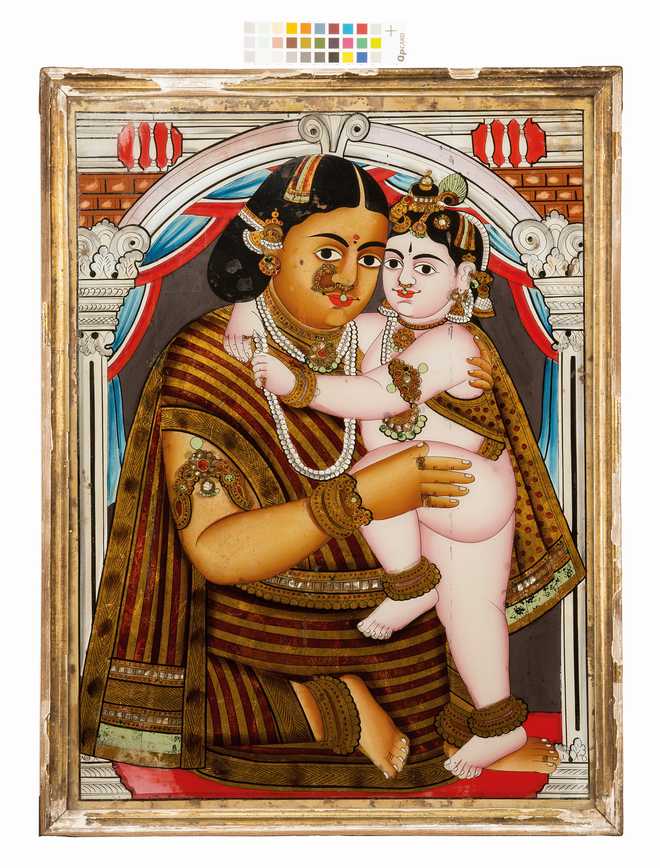
Balakrishna and Yashoda. Southern India, late 19th or early 20th century
Anna L. Dallapiccola
Reverse glass painting is a fascinating, yet comparatively unknown genre of Indian art. It flourished in the mid-19th century, a period characterized by international contacts, artists working for British or ‘company’ patrons and the introduction of new techniques such as watercolour, lithography, and by 1850, photography. Considered, generally a ‘folk’ art, and as such comparatively unknown to both collectors and scholars, it was very popular throughout Indian society. Eventually, the existence of reverse glass painting was cut short first by the introduction of wood engravings which enjoyed a great popularity in the late 19th century, and then by the introduction of chromolithographs.
Reverse glass painting originated in Europe and was widely used mainly to illustrate religious themes. In the course of the 16th century its technique was refined and simplified in Italy, probably in Venice, from where spread throughout Europe from Spain to Poland. During the 17th and 18th centuries this form of art was greatly appreciated and eventually patronized by the Church and the nobility of Central Europe. One of the most celebrated examples is the magnificent mid-18th century Spiegelkabinett (‘Hall of Mirrors’) at the residence of the Prince-Bishop in Wuerzburg, Germany.
Apart from these masterpieces displaying a consummate virtuosity, most of the reverse glass paintings were executed by not by professional artists but by glaziers, pedlars and amateur painters. In Eastern Europe:
“reverse glass painting had become the favoured medium for votive pictures. The paintings could be finished quickly and sold in great numbers at the sites of pilgrimage. The glass had the added attraction of reflecting the scant light in the dark rooms of the peasant homes. Reverse glass paintings of saints, holy places and miracles were made in great number throughout Europe from 1700 A.D.” (Granoff, 1978: 204)
Until the outbreak of World War I reverse glass painting was a thriving folk art in Central and Eastern Europe, but after World War II it fell into oblivion. It was revived only in the 1990s.
India and reverse glass painting
The 19th century, especially after 1858, spelled a period of prosperity and stability for the ruling and land-owning families, merchant and professional communities in India. Some of them, especially in the urban centres, chose to have a western education. Some also adopted western manners, but only to a certain degree. Many, however, continued to lead a traditional life — especially in matters concerning caste and religion — at their country estates and homes.
Reverse glass painting, once a royal prerogative, was gradually adopted by this class. The paintings were decorative, inexpensive and displaying them on the walls was a way to show that one was keeping up with the times and changing fashions. There was, however, a marked shift in the choice of subjects and the quality of the work executed for these new patrons.
As already mentioned, glass paintings commissioned by the rulers, for instance Tipu Sultan, or the ruling houses of Satara and Kutch in the late 18th or early 19th century focused on portraits of their family, friends, dancing girls or concubines. They were mostly work of foreign artists or in some cases, they had been imported. But the paintings commissioned by the zamindars, merchant and professional communities from the mid-18th to the early 20th century depict mainly deities and religious themes. They were executed by Indian artists and used for private worship in domestic puja rooms or shrines, as well as hung on the walls of the mathas and bhajan halls.
Though the majority of the works of this period are inspired by religion, there were some that depicted dancers, ‘courtesans’ and portraits, often in a formal setting reminiscent of the early photography of the period. Often the portrayed person sits near a table on which is a book or other item suggesting a profession; or stands near a teapoy, a three-legged table, with a flower vase. Very often a draped red curtain enlivens the otherwise monochrome background.
The technique
The term reverse glass painting described both how the painting is executed and how, once completed, it is viewed. The artist began the work by placing a clear sheet of glass over his master drawing. First he proceeded to draw the finer lines and the details of the painting. At this stage metallic foil, coloured or gold paper and sequins, if used, were added. Occasionally, some portions of the picture were left bare and gold or metal foil was fixed behind it. Then the larger areas of opaque colour — tempera was commonly used — were applied. The ‘shading’ which is really a kind of modelling, used to suggest roundness of forms was obtained by a subtle gradation of colours. The painting was then mounted with the unpainted side foremost, so that the painting was seen through the glass.
This laborious technique required a good memory of the whole composition on the part of the artist because its components were sequentially covered while he completed his work. Unfortunately, the fragility of the glass accounts for the breakage and loss of many works.
— Excerpted with permission from Reverse Glass Painting in India by Anna L. Dallapiccola. Niyogi Books.


























